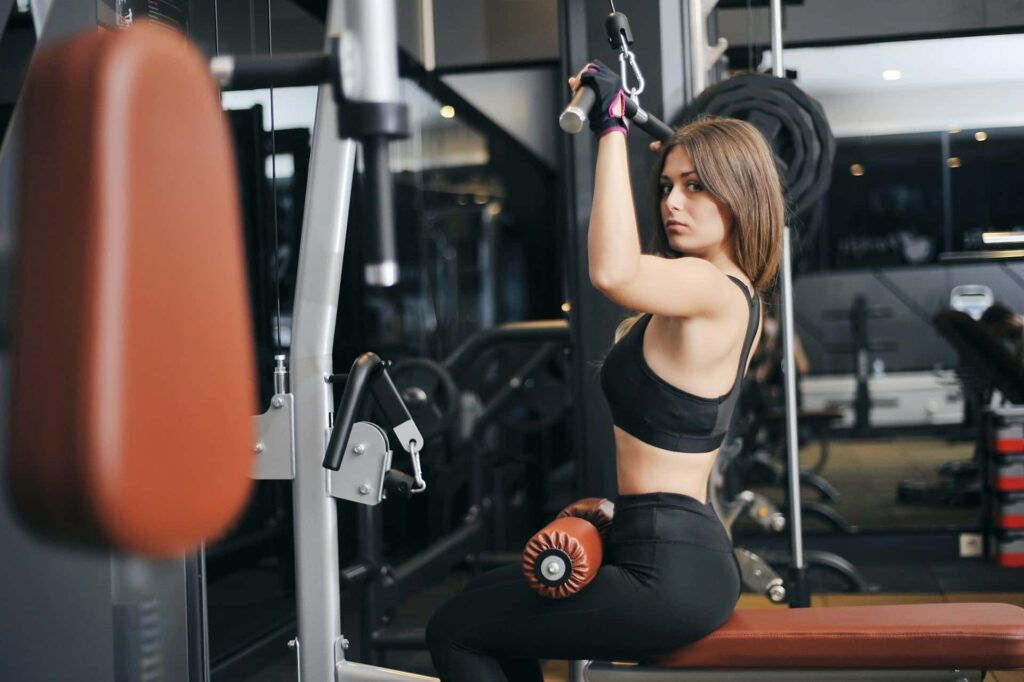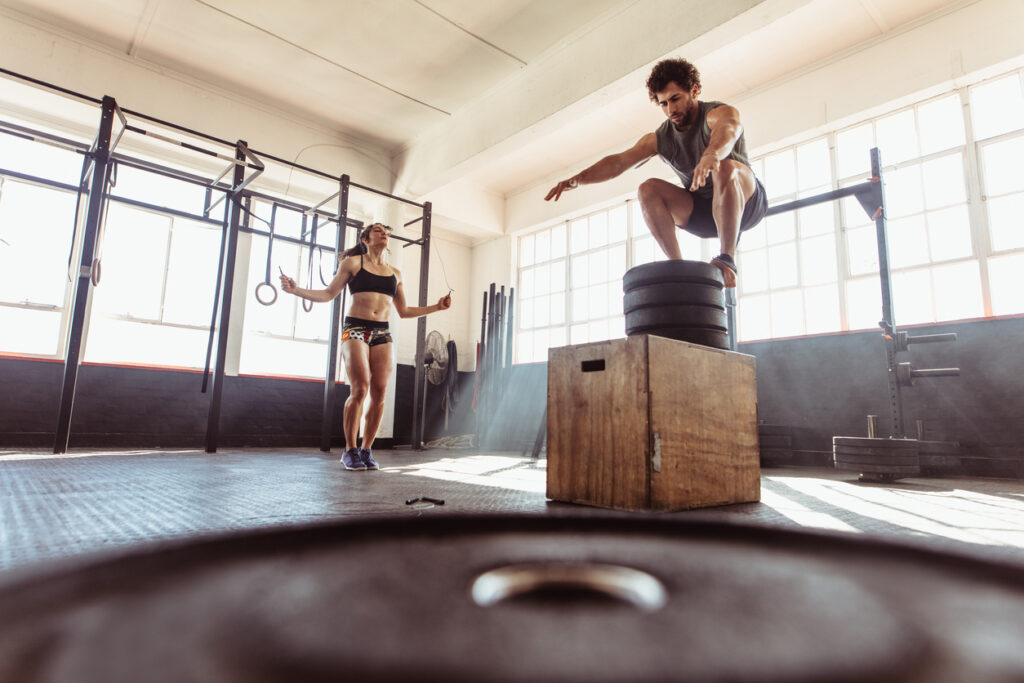
Summary
Welcome / Welcome / Tips for getting started / Shoulder exercise: our selection of exercises for strong shoulders
Shoulder exercise: our selection of exercises for strong shoulders
Looking for effective exercises for strong shoulders? This article is designed to help you strengthen your shoulders with targeted exercises. We cover everything from warm-ups to advanced training programmes.
Discover the importance of warming up to prevent injury and maximise your performance. Learn the best exercises, with and without equipment, to develop your deltoids. Incorporate back exercises for optimal muscle balance.
Ready to transform your shoulders? This article is your complete guide to strong, balanced shoulders. Follow our advice and get started today!
Summary
Understanding shoulder anatomy
The different shoulder muscles
The shoulder is a complex of muscles that allows a wide range of motion. Knowing these muscles is essential to effectively target your workouts.
Anterior, middle and posterior deltoids
The deltoids are divided into three parts:
- Anterior deltoid: Located at the front, it is crucial for pushing movements.
- Medial deltoid: Placed on the side, it is used during lateral elevations.
- Posterior deltoid: At the back, it plays a key role in pulling movements.
Rotator cuff
The rotator cuff is a group of four muscles:
- Supraspinous
- Infraspinatus
- Small circle
- Subscapular
These muscles stabilize the shoulder and allow rotational movements. Neglecting the rotator cuff can lead to injury, so incorporate targeted exercises into your routine.
Role of the shoulders in everyday movements
Strong shoulders aren't just for the gym. They are essential in many daily activities.
Examples of Activities Requiring Strong Shoulders
- Carrying heavy bags: Whether it's shopping or a backpack, strong shoulders make the task easier.
- Lifting objects overhead: Placing a box on a shelf or changing a light bulb requires strength and stability.
- Sports and leisure: Swimming, tennis, or even yoga put a lot of strain on the shoulders.
Having concrete shoulders will help you perform these tasks more easily and reduce the risk of injury. So, don't underestimate the importance of strengthening your shoulders!
The importance of warming up
Prevent Injuries
Imagine you're in the middle of a workout, ready to lift some weights, and suddenly a searing pain stops you dead in your tracks. Sound familiar? That's what can happen without a good warm-up. Warming up is crucial to prepare your muscles and joints for exercise, thereby reducing the risk of injury.
Shoulder-specific warm-up techniques
Before starting your session, it is essential to properly prepare your shoulders. Here are some effective warm-up techniques.
Arm rotation
Arm rotations are simple but effective:
Stand with your arms outstretched.
Make circles with your arms, small at first then larger and larger.
Repeat for about a minute each way.
Dynamic stretches
Dynamic stretches are great for increasing flexibility and blood circulation:
- Front and side raises: Raise your arms in front of you, then to the sides, in a controlled manner.
- Band warm-up: Use a band to simulate pushing and pulling movements.
Incorporating these exercises into your warm-up routine only takes a few minutes but makes a big difference. Not only will you be ready to attack your workout, but you'll also protect your shoulders from potential injury. So, take the time to warm up properly and give your shoulders the attention they deserve!
Exercises to strengthen the shoulders
Exercises with equipment
Using equipment such as dumbbells or bars allows you to vary the exercises and effectively target the shoulder muscles.
Military press
The military press is a classic exercise for developing shoulder strength and mass.
- Hold a barbell at chest height, palms facing forward.
- Push the bar up until your arms are fully extended.
- Slowly lower yourself back to the starting position.
This movement primarily works the anterior and middle deltoids, while engaging the triceps and upper chest. It helps build powerful and well-defined shoulders.
Lateral elevations
Lateral raises are ideal for targeting the middle deltoids and giving nice width to the shoulders.
- Stand with a dumbbell in each hand, arms at your sides.
- Raise your arms out to the sides until they are at shoulder height.
- Come back down slowly without touching the body.
For variety, you can do front raises or dumbbell raises while seated. These exercises isolate the deltoids and help balance the shoulder musculature.
Bodyweight exercises
No equipment? No problem. Bodyweight exercises can also effectively strengthen your shoulders.
Push-ups in pike position
Push-ups in the pike position mainly work the anterior deltoids and trapezius.
- Start in a plank position with your hands slightly wider than your shoulders.
- Lift your hips towards the ceiling to form an inverted "V".
- Bend your elbows to lower your head toward the floor, then push back.
- Keep your back straight and engage your abs to stabilize the body. This exercise is perfect for strengthening the shoulders and improving stability.
Bench Dips
Bench dips are excellent for working the anterior deltoids and triceps.
- Place your hands on the edge of a bench, feet on the floor, legs straight.
- Lower your body by bending your elbows until your arms are at a 90-degree angle.
- Come back up by pushing on your palms.
To increase the difficulty, place your feet on another bench or add weight on your knees.
These exercises, with or without equipment, will help you develop strong, balanced shoulders. Incorporate them into your routine for optimal results!
Integrate back exercises for balanced shoulders
Why work your back with your shoulders
You might think that strengthening the shoulders is enough to achieve a well-developed upper body. Think again ! It is essential to incorporate back exercises to create muscular balance and prevent injuries.
Explanation of muscle synergy
The shoulders and back often work together. A strong back stabilizes your shoulders and improves your posture. Additionally, well-balanced shoulders reduce the risk of muscle imbalance, which can lead to pain and injury. For example, when you do military presses, your back muscles stabilize your body, allowing for better execution of the movement.
Additional exercises for the back
To achieve this balance, add specific back exercises to your routine.
Horizontal draw
The horizontal pull-up is an excellent exercise for developing back width and thickness.
- Sit at the horizontal pull-up machine with your feet firmly planted.
- Grip the bar with an overhand grip (palms down).
- Pull the bar toward your abdomen, squeezing your shoulder blades.
- Slowly return to the starting position.
For variety, try pulling with a supinated grip (palms up) or using dumbbells for horizontal pulls with one arm at a time. This also engages the posterior deltoids and rhomboids, contributing to balanced muscle development.
Pullover with dumbbell
The dumbbell pullover is perfect for working both the back and shoulder muscles.
- Lie on a bench with a dumbbell held in both hands above your chest.
- Slowly lower the dumbbell behind your head, keeping your arms slightly bent.
- Return the dumbbell to the starting position above your chest.
This movement uses the latissimus dorsi, pectorals and deltoids. Be sure to maintain good technique to avoid overloading the shoulders.
By incorporating these back exercises into your routine, you will not only strengthen your shoulders but also your entire upper body. This helps you avoid muscle imbalances and maintain good posture, essential for optimal performance in the weight room and in everyday life.
Shoulder Workout Programs
Beginner Program
If you are new to bodybuilding, it is important to start with simple and effective exercises to gradually strengthen your shoulders.
Frequency and progression
As for frequency, train your shoulders twice a week to allow sufficient recovery.
In terms of progression, start with light weights and gradually increase the load every two weeks.
Example program:
- Dumbbell military press: 3 sets of 12 repetitions
- Lateral raises: 3 sets of 15 repetitions
- Push-ups in pike position: 3 sets of 10 repetitions
- Bench Dips: 3 sets of 12 reps
Remember, the key is to focus on correct form rather than weight. This will prevent injuries and ensure continued progress.
Advanced program
For experienced exercisers, an advanced programme should include a variety of exercises and increased intensity to stimulate muscle growth.
Intensity and periodization
Increase the weights and reduce the number of repetitions to stimulate the muscles more intensely.
Alternate between periods of high intensity and recovery to avoid overtraining.
Example program:
- Barbell military press: 4 sets of 8 repetitions
- Dumbbell Front Raises: 4 sets of 12 reps
- Chin pull-up on the bar: 4 sets of 10 repetitions
- Dumbbell bird: 4 sets of 15 repetitions
- Superset: Pike position push-ups and bench dips: 3 sets of 10 repetitions each exercise
This advanced programme incorporates super sets to increase intensity and challenge muscles in different ways. Make sure you warm up before each session and include rest days to optimise recovery.
By following these programs adapted to your level, you can develop powerful and balanced shoulders. Incorporate these exercises into your routine and adjust the load based on your progress for optimal results.
Nutritional Tips for Muscle Recovery
Foods rich in protein
Muscle recovery requires above all a diet rich in protein. These nutrients are essential for repairing and building muscle tissue after an intense workout.
List and benefits for muscle repair
- Chicken and turkey: Low in fat and high in protein, these white meats are perfect for fueling your muscles.
- Oily fish: Salmon and mackerel are not only rich in protein, but also in omega-3s, which reduce inflammation.
- Eggs: A complete protein source, eggs contain all the essential amino acids needed for muscle repair.
- Dairy: Greek yogurt, cottage cheese and milk offer protein and probiotics for better digestion.
- Legumes: Lentils, chickpeas and beans are excellent vegetarian options, rich in protein and fiber.
Including these foods in your diet will help maximize recovery and promote muscle growth.
Hydration and rest
Hydration and rest are just as crucial as nutrition for optimal recovery.
The importance of hydration
Water is essential for transporting nutrients to the muscles, enabling optimal recovery and growth. It also facilitates the elimination of toxins produced during exercise, helping to prevent muscle soreness and injury. It is recommended that you drink at least 2 litres of water a day to maintain a good level of hydration, and this quantity should be increased in the event of intensive training.
It's important to hydrate regularly throughout the day, and not just during exercise sessions. Waiting to drink until you're thirsty is often a sign that your body is already dehydrated. For optimum hydration, it's also advisable to include drinks containing electrolytes, especially after particularly intense sessions. These drinks help to replace the mineral salts lost through perspiration and maintain the body's water balance.
The importance of rest
Sleep plays a fundamental role in the process of building muscle and improving physical performance. It is during sleep that your body repairs and rebuilds itself, in particular by regenerating muscle fibres damaged during training. A good night's sleep promotes the release of growth hormones, which are essential for muscle recovery and construction. To optimise these processes, it is recommended to sleep between 7 and 9 hours a night.
By combining a protein-rich diet with adequate hydration and quality sleep, you put the odds on your side for effective and rapid muscle recovery. These simple but essential tips will help you come back stronger with every workout.
Conclusion
Strengthening your shoulders is essential for better performance and injury prevention. Follow programmes adapted to your level, incorporating exercises with and without equipment. Don't forget the importance of warming up and nutrition for optimum recovery.
Incorporate back exercises for balanced muscle development. Combine this with a protein-rich diet and good hydration to maximize your results. Every effort counts to achieve your bodybuilding goals.
Explore other articles to diversify your training and discover additional nutritional advice. Discover specific exercises, or crossfit exercises or HIIT. Keep on learning to improve your performance and your well-being. Your bodybuilding journey is just beginning!
Strengthen your shoulders at DRIP
Want to feel your shoulders burn? Push your limits and boost your strength with our HIIT sessions at DRIP! Join our intense 50 minute sessions.
At DRIP, enjoy an energising atmosphere from the moment you arrive, with seven workshops in three series for a constant challenge. Our motivating coaches will guide you through unforgettable playlists. DRIP offers a space suitable for all levels to sculpt your legs. You'll love hating us! ❤️🔥
Share
Tagged
Read also
follow us
on instagram
To follow all our news,
take advantage of our tutorials and participate
in our many competitions.
BREAKING NEWS!
Receive our newsletter.





